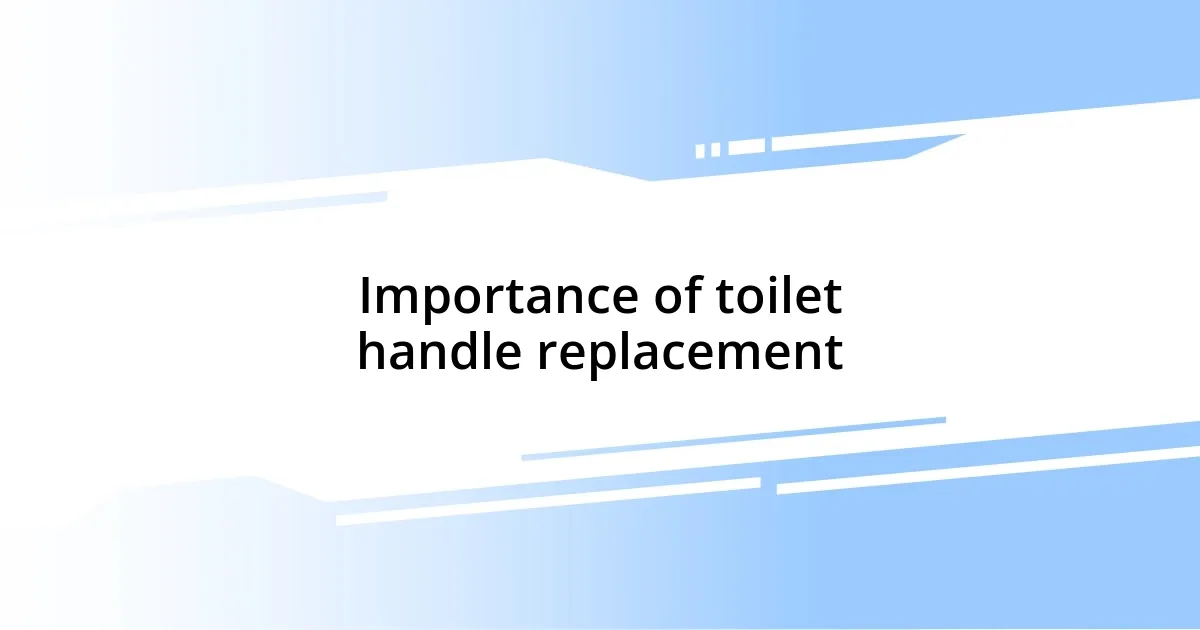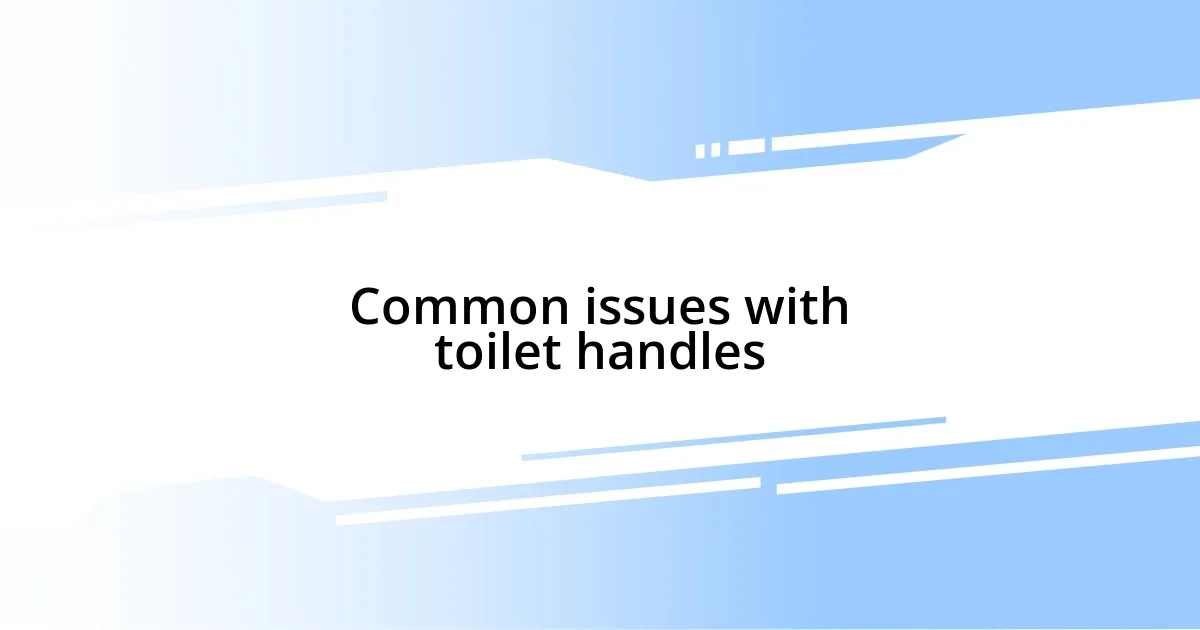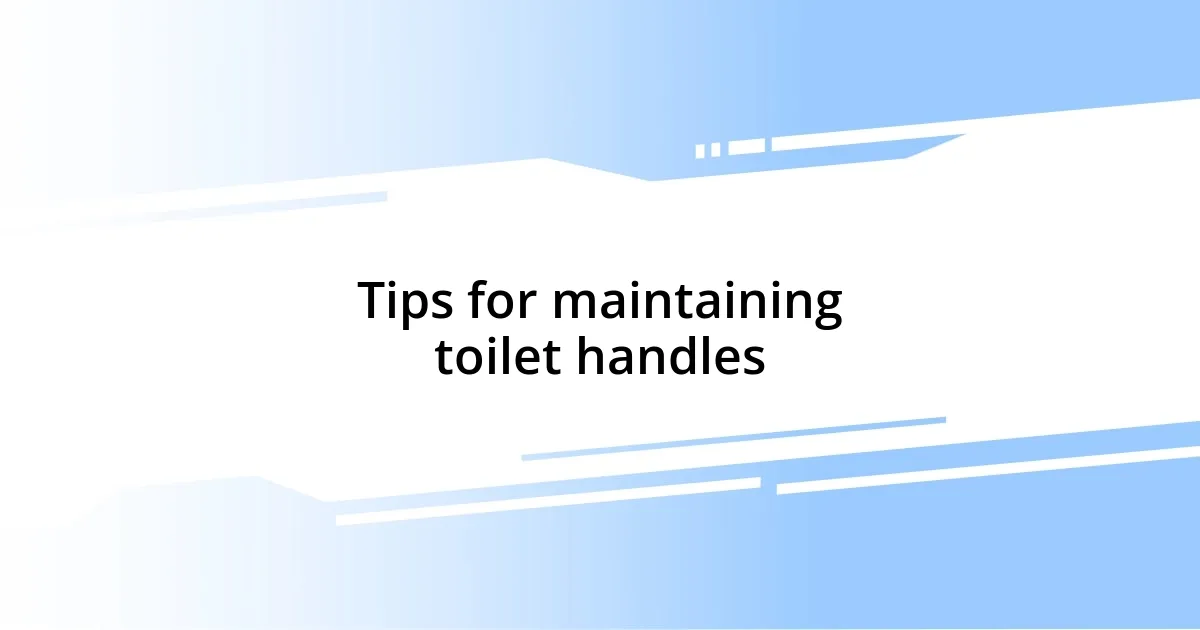Key takeaways:
- Toilet handles are essential for functionality and can significantly impact bathroom aesthetics and hygiene.
- Replacing a toilet handle improves performance, enhances the bathroom’s look, and increases property value.
- Basic tools required for replacement include a flathead screwdriver, pliers, an adjustable wrench, and a towel or bucket.
- Regular maintenance, including cleaning and checking for looseness, can prevent common issues and prolong the handle’s life.

What are toilet handles
Toilet handles, the small yet vital components of every bathroom, serve as the mechanism that initiates the flushing process. They come in various designs, from sturdy chrome models to more modern push-button variants, each adding a different flair to bathroom aesthetics. Have you ever really thought about how often you interact with this simple device, often taking it for granted?
In my experience, replacing a toilet handle can feel surprisingly satisfying. I remember the first time I did it; I was almost amazed at how a little hardware could impact the entire bathroom experience. It was refreshing to turn a shiny, new handle that operated smoothly, freeing me from the annoying drag of its broken predecessor. Isn’t it fascinating how such a small part can bring a sense of completion to a space?
Toilet handles not only provide functionality but also embody a small piece of our daily routines and rituals. Think about the last time you dealt with a stubborn handle; it can be frustrating in that moment, but once replaced, it feels like a little victory in homeownership. Doesn’t it make you appreciate the little things we use every day, yet seldom notice?

Importance of toilet handle replacement
Replacing a toilet handle is more than just a maintenance task; it significantly enhances your bathroom experience. I can recall a time when a stubborn handle made a simple task feel like a wrestling match. Once I replaced it, the operation became effortless, turning what was once a source of irritation into a smooth motion. It sounds trivial, but it brought a little joy into my daily routine.
Here are a few reasons why replacing toilet handles is important:
- Improved Functionality: A new handle ensures every flush is smooth and efficient, reducing the risk of leaks or annoying malfunctions.
- Aesthetic Appeal: Upgrading the handle can elevate the look of your bathroom, creating a fresh and inviting atmosphere.
- Enhanced Hygiene: Old handles can harbor germs; replacing them helps maintain a cleaner environment in a frequently used space.
- Increased Property Value: Even small updates can contribute to the overall impression of your home. A well-maintained bathroom can be a selling point.
- Sense of Accomplishment: Successfully completing this simple DIY task can provide a surprising boost in confidence and satisfaction.

Tools needed for replacement
When it comes to replacing toilet handles, having the right tools makes the job much smoother and more enjoyable. From my experience, all you typically need is a few basic items. A flathead screwdriver and a pair of pliers can handle most handle replacements. The screwdriver helps to remove screws, while pliers grip any stubborn nuts that refuse to budge. I remember once using a really old screwdriver that slipped a lot—what a hassle! Switching to a better one made the process ten times easier.
Another essential tool is an adjustable wrench. It provides versatility, allowing you to tighten or loosen various fittings. In my first DIY project, I underestimated the importance of this tool. I struggled with a flimsy wrench that just didn’t cut it. Upgrading to an adjustable wrench made a world of difference, speeding up the entire process and boosting my confidence.
Don’t forget about a towel or a small bucket, either. I learned the hard way that water can sometimes sneak out during removal, and having something to catch it can save a mess later on. These simple tools come together to make the replacement seamless and satisfying!
| Tool | Purpose |
|---|---|
| Flathead screwdriver | Remove screws from the handle |
| Pliers | Grip and pull stubborn nuts |
| Adjustable wrench | Tighten or loosen fittings |
| Towel or bucket | Catch any water that spills |

Step by step replacement guide
Start by gathering your tools, ensuring you have everything ready before diving in. I remember when I replaced my first toilet handle, the excitement surged through me, but I quickly realized I was missing my pliers. What a frustrating delay! Time spent preparing can prevent those annoying hiccups, allowing you to focus on the task at hand without unnecessary interruptions.
Next, turn off the water supply to avoid any surprises. I made the rookie mistake of skipping this step once, and let me tell you, water sprayed everywhere! It’s crucial to drain the toilet by flushing it and holding the handle down. Sure, it can feel tedious, but taking this precaution can save you from a cleaning disaster later.
Finally, disconnect the old handle. You’ll need to remove the screws securing it in place. I distinctly recall fumbling with my screwdriver while trying to balance the tension from the chain attached to the flapper. It was a comedy of errors! Just remember to take your time; patience truly pays off. After everything is detached, installing the new handle should feel like a breeze, transforming your experience from laborious to effortless!

Common issues with toilet handles
Sometimes, the simplest things can cause the biggest frustrations. I’ve encountered a few pesky issues with toilet handles over the years. One of the most common problems is a handle that simply won’t flush. I remember trying to make a handle work that was jammed due to minerals buildup—talk about a headache! I had to remove the handle entirely, clean the mechanism, and then reattach it.
Another issue that frequently pops up is the handle feeling wobbly or loose. This can often indicate that the mounting nuts beneath the tank lid are not tight enough. I once had my handle nearly detach while my family was trying to flush; it was quite the embarrassing moment! Making sure everything is securely fitted can save you from those awkward scenarios.
Finally, let’s not forget about the dreaded breakage. Handles can crack or snap with age, especially if they’re made from lower-quality plastic. I faced a mishap when a handle gave out unexpectedly during a dinner party, leaving me scrambling to find a quick fix. Investing in a sturdier replacement can prevent such embarrassing, last-minute repairs and ensure reliability over time. Why risk that kind of chaos?

Tips for maintaining toilet handles
When it comes to maintaining toilet handles, regular checks can make a world of difference. I’ve learned that simply giving a gentle wiggle to the handle can help identify any looseness before it becomes a major inconvenience. Have you ever felt that unsettling jiggle when you flush? It’s a small sign that could lead to bigger problems if ignored.
Cleaning is another essential part of maintenance. I like to wipe down the handle with a damp cloth regularly, especially since it’s a high-touch area that can accumulate dirt and grime. There’s something oddly satisfying about keeping that shiny finish bright—plus, it helps me avoid any awkward comments from guests about a neglected bathroom!
Finally, don’t forget to check the internal mechanisms periodically. Once, I ignored a small squeak, thinking it was just an annoying little sound. That squeak turned into a not-so-great experience when the handle got stuck midway through a flush. Trust me, a simple drop of lubricant on the moving parts can save you from those unexpected moments of panic. Have you thought about the last time you really gave your toilet handle some love? A few minutes can keep the flush smooth and stress-free!














